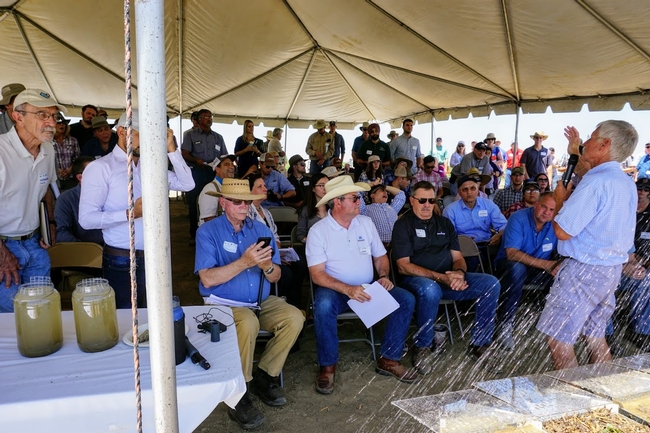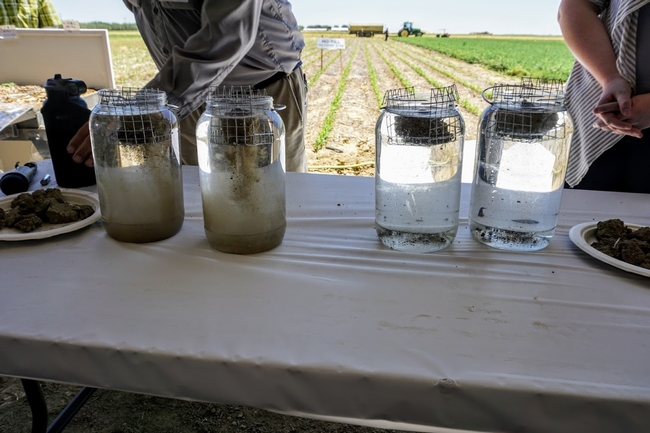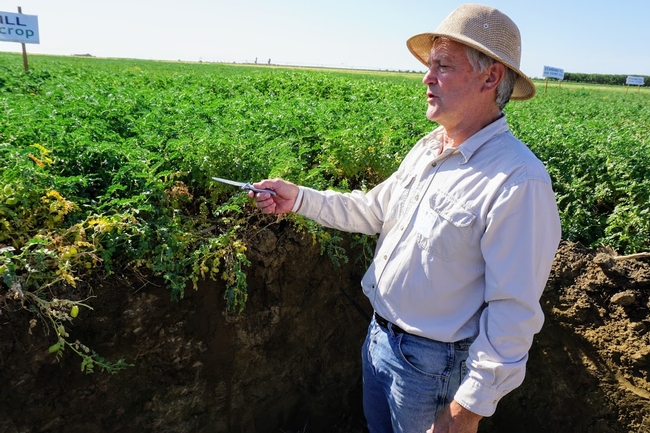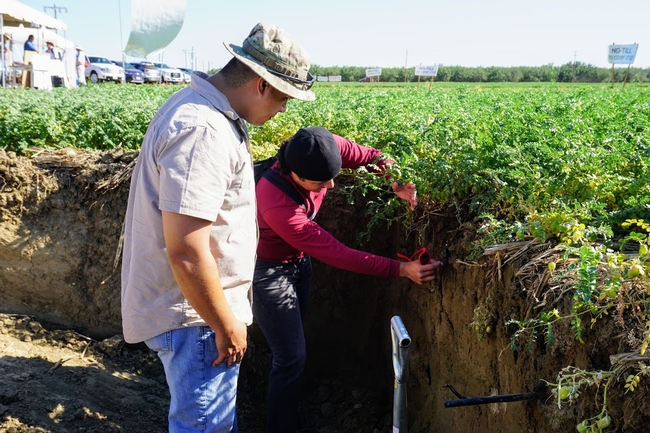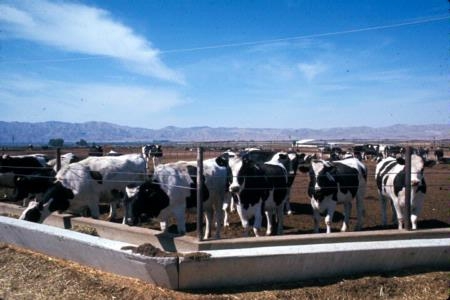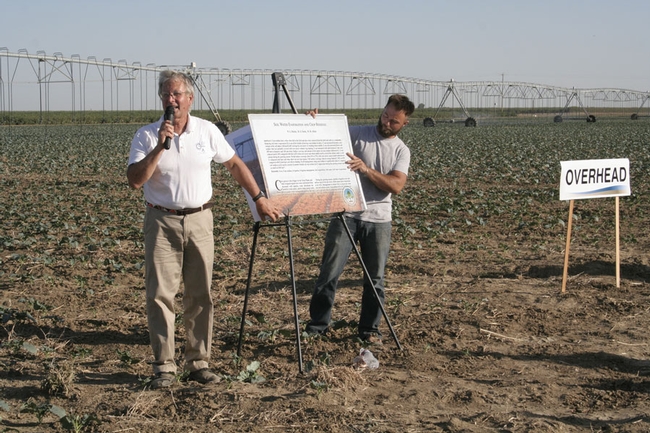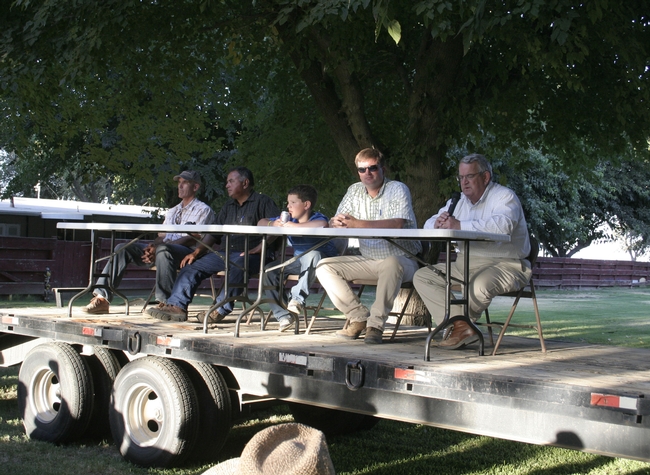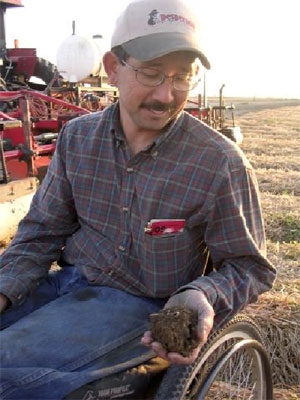Posts Tagged: Conservation Agriculture Systems Innovation
Better soil boosts farm profit and benefits the planet
Healthy soil does much more than hold plants upright on the surface of the earth. It is a mix of mineral bits and old plant particles teeming with microbes to form a mysterious and complex web of life scientists are just beginning to understand.
While scientists use high technology to study heathy soil – painstakingly counting soil worms and bugs, sequencing the DNA of soil bacteria, for example – some farmers know intuitively whether the soil is healthy just by walking on it.
Scott Park is a first-generation Meridian, Calif., farmer. “When I step on a field and it feels like a road, something is wrong,” he said. “If it feels like a marshmallow or sponge, that's good.”
Park shared his farming experiences with 200 farmers, industry representatives, University of California Cooperative Extension scientists, Fresno State students, news media and others during a half-day UC workshop at the UC West Side Research and Extension Center in Five Points.
“The last 31 years I've been on a mission of building soil,” Park said. “I discovered it by accident and I've made lots of mistakes. But yields trend upwards every year on every crop. Being sensitive to building soil, I'm making a lot of money. And if I'm doing something for the earth, all the better.”
Park said he adds 10 to 15 tons per acre of biomass to his farm every year. He's using less fertilizer, up to 20 percent less water, and even experimenting on the farm by growing a commercial crop with just four inputs: cover crops, water, seed and sun.
“We got high-yielding, good-quality crops,” Park said. “Nobody was more shocked than I am that I got a good crop.”
Researchers are now using the scientific method to figure out the root causes of these empirical observations.
“There's a lot going on in soil,” said Radomir Schmidt, a UC Davis soil microbiologist who spoke at the soil health field day.
A teaspoon of soil has a billion bacteria and six miles of fungal hyphae, the filaments that branch out through the soil from fungi, Schmidt said. The microbes' interaction with living plant roots, the larger pores left by decomposing vegetation and tunneling worms and insects create a system that confers resilience to unforeseen challenges – such as pest pressure, torrential rainfall and plant diseases.
The field day was held under a tent pitched adjacent to an 18-year research trial at the 320-acre facility. The trial compares four farming systems side by side:
- Conventional system, with annual soil tillage and no cover crops.
- Conservation agriculture, with no tilling whatsoever and annual winter cover crops.
- No-till without the cover crop.
- Conventional tilling with a cover crop.
“Take a look over my shoulder to see the difference,” said Jeff Mitchell, UC Cooperative Extension specialist and the study leader. “We've found the cover crops and no-till reduce water needs, cut dust, and lower costs. And there may be more benefits than we realized.”
For example, a graduate student counted the worms, bugs, beetles and other microfauna in soil samples from each of the treatments. There were double the amount in the no-till, cover crop plots compared to the conventional farming system.
UC Cooperative Extension specialist Sloan Rice found that cover crops promote water retention in the soil after rainfall. There is very little water evaporation from the soil surface and water transportation from the cover crop plants in the winter, so little water is lost. Cover crops also promote more water infiltration below three feet.
Healthy soil management also shows promise in confronting global climate change by sequestering carbon in the soil, rather than depleting it.
Manager of Sano Farms in Firebaugh, Jesse Sanchez, was a speaker at the field day. He wasn't surprised by the overflow crowd.
“Farmers are more and more curious. They see some of us using cover crops, and they want to learn more,” Sanchez said. “There has been a swell of interest. I have a tremendous number of visitors every year.”
For more information about soil building, see the UC Conservation Agriculture Systems Innovation website at http://casi.ucanr.edu.
Leaving crop residues in the field improves water use efficiency
Managing crop residues to essentially make them disappear has been the norm in California agriculture.
But a growing body of research, and experience with conservation tillage on thousands of acres of Central Valley farmland, is showing that reducing tillage and leaving crop residues on the soil surface can improve water use efficiency.
“Crop residues are an inevitable feature of agriculture,” Jeffrey Mitchell, cropping systems specialist in the Department of Plant Sciences, UC Davis, wrote in the April-June 2012 issue of California Agriculture journal. “Because no harvest removes all material from the field, the remaining plant matter accumulates and is typically returned to the soil through a series of mixing and incorporating operations involving considerable tractor horsepower, an array of tillage implements and cost.”
Conservation tillage is a suite of low-impact cultivation practices that includes leaving crop residues on the soil surface and planting new crops on top, significantly decreasing the number of tractor passes needed to prepare fields for planting. In turn, growers reduce their fuel, labor and maintenance costs, and less dust and pollution gets into the air.
In two field studies conducted at the UC West Side Research and Extension Center in Five Points, no-tillage and standard tillage operations were compared in a corn/wheat rotation. Mitchell and colleagues found that 0.89 and 0.97 inches more water was retained in the no-tillage soil than in the tilled soil.
And in three field studies on crop residue coverage, about 0.56, 0.58 and 0.42 inches more water was retained in residue-covered soil than in bare soil following 6 to 7 days of overhead sprinkler irrigation. The full study results are published in the April-June 2012 California Agriculture journal.
The authors estimated that coupling no-tillage with practices that preserve high residues on the soil surface can reduce evaporative losses during the summer by about 4 inches (13 percent), assuming a seasonal evapotranspiration demand of 30 inches.
In widespread use in other regions of the country, conservation tillage practices appear to be catching on in California. In surveys conducted by Sustainable Conservation and the UC Conservation Agriculture Systems Initiative, the amount of farmland under conservation tillage statewide grew by nearly 20 percent between 2008 and 2010, to about 1 million acres.
Mitchell and colleagues warn that a number of practical factors must be addressed before a wholesale transformation to no-tillage, residue-preserving production can be envisioned in California: “These include the relative ease with which a farm's existing cropping mix might be converted to no-till, the need for and cost of new equipment and the learning curve for new management practices.”

A two-year study compared soil water content in tilled (right, subsoil ripped) and no-tillage (left) plots.
California conservation tillage acreage increasing
The amount of California farmland being cultivated using conservation tillage techniques is continuing to expand, according to a survey by California’s Conservation Agriculture Systems Institute (CASI).
The survey tallies silage and grain corn; small grains for hay, silage and grain; tomatoes, cotton, dry beans, and melons managed as no-till, strip-till, ridge-till and mulch-till – which leave at least 30 percent of residue from the previous crops on the soil surface – in the nine-county Central Valley region. In 2010, such conservation tillage accounted for about 14 percent of the crops’ total acreage, an increase from about 10 percent in 2008. The survey also found that minimum tillage practices – which reduce the overall number of tillage passes by at least 40 percent relative to what was done in 2000 – were used on about 33 percent of crop acreage in 2010, up from about 21 percent in 2008.
There are many potential benefits for using conservation tillage, said UC Cooperative Extension cropping systems specialist Jeff Mitchell. Conservation tillage is credited with water conservation, dust suppression, reduced pesticide runoff into surface water, lowered labor needs and costs, and fuel savings. In addition, limiting tillage helps to keep carbon in the ground and prevent the buildup of greenhouse gases in the atmosphere.
CASI has conducted comparisons of annual row crop acreage farmed under different tillage systems in the Central Valley region since 2004. More than 35 Natural Resources Conservation Service, University of California and private sector experts take part in the survey.
The largest change in conservation tillage acreage from 2004 to 2010 is found in the amount of corn silage acreage that uses strip-tillage. In 2004, there were only about 490 acres of summer silage corn using strip-till, while in 2010 more than 103,000 acres in the San Joaquin Valley dairy region had adopted this form of conservation tillage. The overall use of minimum tillage practices has also greatly increased during this time from about 64,000 acres under reduced pass tillage in 2004 and just over 700,000 acres under minimum tillage in 2010.
California’s Conservation Agriculture Systems Institute involves more than 1,500 farmers, industry representatives, university, Natural Resource Conservation Service and other public agency members. Over the past 10 years, the team has come together to develop information on the costs and benefits of the production system and irrigation management alternatives and to develop long-term sustainability goals. For more information on the body of CT research, see the UC Conservation Tillage website.
The body of CT research knowledge continues to grow
UC scientists presented recent additions to the growing body of research on conservation tillage in California at the second annual Twilight Conservation Tillage and Cropping Systems field day last month, demonstrating progress in agricultural systems that will help farmers cut production costs, reduce soil disturbance and save water.
UC scientists and their partner farmers are conducting research that addresses the current needs of the San Joaquin Valley agricultural industry and research that is looking to the future by anticipating changes that may need to be negotiated in coming decades.
During the field day at UC's West Side Research and Extension Center in Five Points, Calif., participants visited two primary research areas. The first is the longest-standing conservation ag system study in California, where a cotton/tomato rotation has been farmed for 12 years running. The plots include standard tillage with and without cover crops and conservation tillage with and without cover crops.
“This might be the most-visited research field in California,” said Jeff Mitchell, UC Cooperative Extension vegetable crops specialist and chair of the CT workgroup. “Many students and scientists have conducted research here.”
For example, scientists have been able to quantify significant improvements in soil quality with the use of cover crops and conservation tillage. UC Davis soil biochemist Will Horwath reported that conservation tillage combined with an off-season cover crop has increased the soil carbon content close to five tons per hectare.
“Is that significant?” Horwath asks. “Yes. In 10 years, we have almost doubled the soil carbon content.”
Because of the valley’s dry, hot climate, the native soils are typically very low in carbon, which is a characteristic of low soil quality. Carbon in the soil acts as a glue, helping reduce wind erosion.
At the second research field, conservation tillage research is being combined with overhead and subsurface drip irrigation. Coupling overhead irrigation with conservation tillage is common in other regions of the U.S., but is just beginning to get attention in California.
“There are more than 17,000 center pivots in the state of Nebraska, and it is estimated that there are somewhere between 300 and 500 pivots currently in use in California, the No. 1 ag state in the nation,” Mitchell said. “This situation is changing rapidly.”
Overhead irrigation is efficient, automated, allows for diverse cropping and, with soil residues from conservation tillage, permits uniform infiltration.
Four users of overhead irrigation shared their experiences with the irrigation system at the field day. West side farmer John Deiner said mechanized irrigation has significantly reduced labor input in his agronomic crops while boosting crop yields.
“Our corn grew two to three feet taller under the pivot,” he said.
Will Taylor of King City grows potatoes for In and Out Burger under center pivots. He said his yields are 20 percent higher when using the overhead irrigation system.
“Once you overcome challenges,” Taylor said, “they’re awesome.”
He demonstrated their ease of use by bringing along his 9-year-old son Liam, whom he said can already manage the machine.
Darryl Cordova of Denair uses overhead irrigation in a hilly area on the east side of the valley.
“What used to take three guys six hours of moving pipe is now done with a push of a button on my cell phone,” Cordova said.
Scott Schmidt, who farms across the street from the West Side Research and Extension Center, said he has learned how to successfully use overhead irrigation and conservation tillage from the “school of hard knocks.”
“Most of the problems have been self-inflicted wounds,” Schmidt said. But now, he calls the system “flawless.” “We have seven pivots that I operate remotely from my phone.”
Earthworms signal success on innovative tomato farm
If the return of earthworms to farm fields is an indication of success, then Sano Farms is on the right track.
“I haven’t seen earthworms in these fields in years,” said Firebaugh farmer Alan Sano. Sano and his partner, Jesse Sanchez, combine subsurface drip irrigation, winter cover crops and strip tillage to consistently produce a high-yielding crop of processing tomatoes.
In addition to boosting yield, the system they developed for the 4,000-acre farm is cheaper, increases soil organic matter and improves the tilth of their silty clay soil.
The farmers took several trips to the Midwest and consulted with UC Davis Cooperative Extension specialist Jeff Mitchell to learn the improved management techniques they applied on the farm.
After switching from furrow irrigation to drip, Sano and Sanchez began experimenting with cover crops.
"It wasn’t always an easy transition into cover crops," Mitchell said. "It did take some time to learn the best way to manage them."
As the benefits of years of cover cropping accumulated, they saw that they didn’t need to till the entire field to get good soil-seed contact; they only needed to till a strip of soil a few inches wide.
Recently, they shared their innovative farming system with other growers at an open house event sponsored by California's Conservation Tillage and Cropping Systems Workgroup.
Farmers interested in adopting conservation tillage techniques may contact Mitchell for more information at mitchell@uckac.edu.

